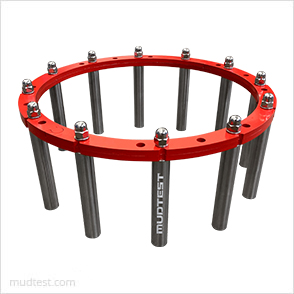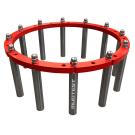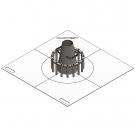J-ring EN 12350-12

The J-ring is used to assess the passing ability of self-compacting concrete to flow through narrow openings including spaces between reinforcing bars. The J-ring consists of several smooth steel bars arranged in a circle, which are held in position by a ring with a diameter of 300 mm.
For the test, the J-ring is placed on the base plate standardized in EN 12350-8. The slump cone, also standardized in EN 12350-8, is placed into the J-ring and filled with fresh concrete. The slump cone is then raised so that the concrete can spread on the base plate. To do this, it must flow through the steel bars of the J-ring. After a specified time, the concrete cake is measured and examined for signs of segregation.
EN 12350-12 describes a J-ring test with narrow bar spacing and one with wide bar spacing. The wide-gap J-ring consists of 12 smooth steel bars held in place by the ring. The narrow-gap J-ring counts 16 plain steel bars.
The MUDTEST J-ring is characterized by the fact that a stable ring can accommodate both 12 and 16 steel rods. No template is required for placement. The steel rods can simply be repositioned in clearly assigned holes in the ring.
Mudtest also offers the L box according to EN 12350-10. The L box test can be performed as an alternative to the J-ring test.
| J-ring BS EN 12350-12 | 6012.41.00000 |

